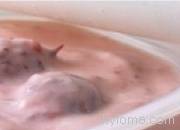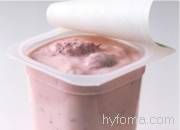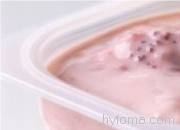 download article
download articleFermented Milk Products
Fermented milk products were first made in the Near East in the Caucasus region. The first product that must be mentioned here is kefir and the second yogurt. The name yogurt originates from the Turkish and has its roots in the 8th century.In order to make milk products such as yogurt, soured butter milk, sour cream and kefir, starter cultures are added to milk to ferment the lactose contained in the latter. Aldehydes, lactic acid and carbon dioxide are produced during this process. The cultures used to make kefir also produce ethyl alcohol.
In order to create ideal fermentation conditions, the raw milk for all products in this group must be totally free of germs. It is standardized, homogenized and then cooled down to the ideal temperature for the starter culture. Incubation/fermentation takes place at this temperature. Once the ideal point has been reached in this process, the product is cooled down.
Characteristics of yogurt, kefir, sour cream and butter milk
Yogurt is the most widespread of the above-mentioned products. It is consumed in liquid, compact or frozen form. There is a production variant for every form of yogurt. The incubation temperature ranges between 40°C and 45°C. Fruit yogurt contains 15% fruit, of which around 50% is sugar. Fermentation takes place before or after the filling. By stirring yogurt (best known yogurt in Holland) the fermentation takes place before filling, by the other sorts of yogurt (best known in the remaining countries) fermentation takes place after filling.
Kefir is made from all types of milk and is slightly viscous. The pH value of kefir is 4.3 to 4.4. Since yeasts are involved in fermentation of kefir, alcohol is produced. The incubation temperature lies between 22°C and 25°C for a period of 12 hours. After the coagulum has been stirred, it matures for 12 to 14 hours at a temperature of between 14°C and 16°C. Once the maturing process has been completed (with a pH value of 4.4), the product is cooled down to a temperature of between 5°C and 8°C.
Sour cream (creme fraîche) has a fat content of between 10% and 30%. This product is incubated in a tank after injection of the starter culture for a period of around 18 to 20 hours at a temperature of between 18°C and 21°C. This process may also take place in the packaging. This should be followed by a maturing phase of 24 hours at a temperature of 6°C. The cream can be homogenized and subjected to short-time heat treatment.
Butter milk is a product which occurs during butter making. It is a very unstable product with a very short shelf life. In order to extend its shelf life, lactic acid bacteria are added to the butter milk. Fruit concentrates are often added as well.
 back to top
back to top







 companies
companies


